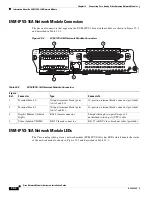
39-3
Cisco Network Modules Hardware Installation Guide
OL-2485-20
Chapter 39 Connecting Cisco Analog Video Gateway Network Modules
Information About the EVM-IPVS-16A Network Module
The RS-485 ports can be used to control camera pan, tilt, and zoom (PTZ) functions, as well as other
RS-485 devices. Because PTZ camera types use different protocols, the EVM-IPVS-16A network
module only supports pass-through mode. In pass-through mode PTZ commands and other data will not
be interpreted.
Alarm Inputs and Control Relay Outputs
The EVM-IPVS-16A network module supports eight contact closure interfaces. Interfaces A0, A1, A2,
and A3 can be configured as alarm input or relay output, the other interfaces are input only. They are
used to detect contact trigger events and control external devices.
In most cases, the contact closure interfaces will be connected to a patch panel through the two terminal
block ports on the network module. The patch panel can provide the bias to the circuit.
Caution
The alarm signal input and output (I/O) connections on this unit are intended only for connection to
NEC/CEC Class 2 or equivalent circuit. This means that the voltages applied to alarm signal I/O
connections should not exceed 42.4 Vpk or 60 Vdc and it should be a limited/fused power source. For
more details on Class 2 circuits, refer to the National Electrical Code/Canadian Electrical Code.
Gigabit Ethernet Port
The external Gigabit Ethernet port is disabled by default. If you enable the Gigabit Ethernet interface, it
can act as a routable interface in your network.
Table 39-1
Alarm Input and Output Interface Specifications
Specification
Range
Alarm Input Sense Voltage Range
12 V to 24 V
Alarm Output Current Load Range
0 mA to 170 mA
















































